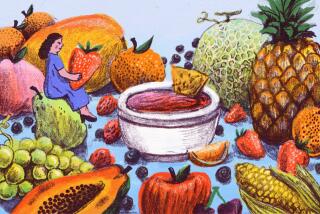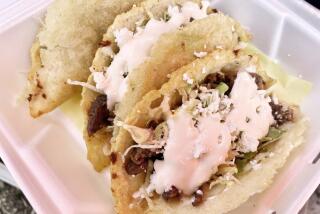For the People of India, Mangoes Are a Luscious Treat--and Big Business : Asia: But of the more than 1,000 varieties of the fruit grown there, only a few are popular abroad.
- Share via
NEW DELHI — It is July, and the thoughts of Indians have turned to mangoes, their juicy and golden reward after months of torrid heat.
The Benazir and the Bhutto are again in season, almost as green as the Pakistani flag. The walnut-sized Angoor Dana (Grape Seed), the blushing Husn-ara (Beauty) and the lime-like Laila are now in markets and people’s pantries.
So, across India, are more than 1,000 other varieties graced with the names of royalty (Prince, Sultan and Viceroy), castes (Thakur and Pandit), locales (Calcutta Amin and Bombay) and attributes (Silky, Delicate and Seedless--plus, for unknown reasons, Lame, Quicksand and Fragile Body).
In India, mangoes are simultaneously a part of history, culture, mythology and religion--and a big, thriving business.
“Mango is indeed India’s gift to the world,” said Gokul Patnaik of the Commerce Ministry, whose job is to sell as many as possible abroad.
Though an exotic, even unknown, object in parts of the Western world, the mango is as inextricably bound up with the land of its origin as the olive tree is with Greece or the grapevine with Italy’s Tuscany. Even the scientific name, Mangifera indica, proudly proclaims the mango’s native land.
The mango has been an integral part of India’s diet and life for at least 4,000 years. It is supposed to have delighted the invading Alexander the Great in 326 BC, and one of the most celebrated of Mogul emperors, Akbar, is said to have had an orchard with 100,000 mango trees, some of which still bear fruit in the present-day state of Bihar.
The glories of the mango brought verse to the appreciative lips of one of the most celebrated of Urdu bards, Mirza Ghalib, who praised its flavor by asserting that “even the sweetest of sugar canes is bland beside it.”
Since time immemorial, the mango has been the symbol of love, pleasure and auspiciousness to Indians. In Hindu mythology, love arrives with the blossoming of the mango tree. Kama, the god of love, tips his arrow with five flowers, one of them the mango blossom. Its leaves are used to sprinkle sacred water in Hindu rituals.
In the ancient holy books, the mango tree is called Kalpavriksha, or “wish-granting tree,” and Buddha, who founded a religion of his own, is supposed to have meditated in its shade.
To honor this “king of fruits”--and try to earn some tourist revenue during a slack season--the Indian capital played host earlier this month to the 7th International Mango Festival. Events included a quiz about mango lore and legend, a messy mango-eating contest and an eye-popping display at Talkatora Indoor Stadium of more than 500 domestic varieties, from the egg-size Anda to the Kakram Jabisaheb, as large as a gourd.
Madan Lal Khurana, the chief minister of the national capital territory of Delhi, inaugurated the festivities with a rousing speech praising the mango as so incredibly delicious that “even a diabetic is tempted to take a slice after meals.”
It is also, Khurana said democratically, a fruit so cheap and plentiful that any Indian can afford it.
On the rain-soaked pavement outside, growers hawked mangoes from crates and their customers happily demonstrated the correct five-step eating technique:
Squeeze the mango all around to liquefy the inside; rip the skin off the top; suck the yellow-orange pulp as though eating an ice pop; when the seed emerges, chew the pulp off it and discard; continue to suck the mango until no pulp remains.
According to Patnaik, the Commerce Ministry’s salesman, the mango’s motherland accounts for about two-thirds of current global production. In the 12 months ending in April, India exported 21,000 tons of fresh whole fruit and 33,000 tons of mango pulp for sauces, yogurt flavoring and tropical fruit juice, earning the country more than $34 million.
But the richness of mango varieties masks the truth about the nature of today’s international market and India’s problems, he said. About 90% of the country’s exports, it turns out, are Alphonso mangoes, primarily from the area around Bombay. The overwhelming majority of other varieties never leave the country because they simply don’t please the foreign eye.
“We go by taste, we don’t go by color, when we Indians decide what mango we like,” said Patnaik, chairman of the ministry’s Agricultural and Processed Food Products Export Development Authority. “Unlike you.”
When Westerners buy a mango, Patnaik explained, they opt first for fruit whose skin has a rosy, peachlike blush. No matter how good its flavor, a green variety like the Benazir (the name means “peerless” and, like the Bhutto, is only coincidentally shared by the prime minister of India’s archenemy, Pakistan) consequently appeals to few non-Indians.
To alert Indian mango growers and shippers to what the competition is up to and what pleases Western taste buds and eyes, Patnaik had rosy-cheeked mangoes from Kenya, Gambia, Jamaica, Venezuela and other producing countries flown into Delhi and put on display at the festival.
“Unpopular varieties have trouble competing for a place in the supermarket,” he noted in a speech at the festival opening.
It was an open invitation to the growers of India, his country, who have more than 1 million acres planted with mango trees, to reflect on whether their crop is the right variety.
Indian producers are faced with an additional, and very formidable, hurdle when it comes to the United States: They don’t meet current Agriculture Department guidelines designed to guard against an infestation of the Oriental fruit fly.
That should now change, Patnaik said. The Japanese, who have similar regulations, are donating a pilot vapor-heat fruit treatment plant, to be constructed in the Delhi area, that would eliminate the fruit fly danger.
The next U.S. requirement would be on-site inspection to verify that the fruit is being properly treated, and Patnaik said his government has already asked that an Agriculture Department inspector be based in India.
As well as the whole fruit, Indians eat at least a score of mango dishes, including “hot mango pickle,” where the mango is doused with an incendiary mixture of red chili powder, mustard powder, turmeric, fenugreek, salt and other spices.
For Indians, the mango is the symbol of life’s pleasures.
“But most Americans don’t even know what a mango is,” Patnaik charged.
His goal is to open the U.S. market to the Indian-grown delicacy that conquered Alexander the Great.
More to Read
Sign up for Essential California
The most important California stories and recommendations in your inbox every morning.
You may occasionally receive promotional content from the Los Angeles Times.










